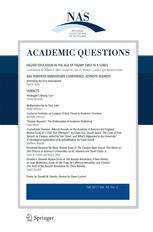Michelle Marder Kamhi is an independent scholar and critic, co-editor of Aristos, an online review of the arts, and the author of Bucking the Artworld Tide: Reflections on Art, Pseudo Art, Art Education & Theory (Pro Arte Books, 2020); www.mmkamhi.com.
The cancellation early this year of a very popular, long-standing Yale undergraduate survey course on Western art understandably provoked a considerable outcry among cultural conservatives. As the latest rejection of an allegedly outmoded canon focused on “dead white men,” the move was clearly inspired by the current academic obsession with “diversity,” consistent with other like-minded curricular changes and with the introduction of “all-gender” bathrooms at Yale.
Specious claims made by the college’s Art History Department to justify the cancellation were thoroughly dissected by Heather Mac Donald.1 Her perspective was informed by her having taken the first half of the two-semester course (“Introduction to the History of Art: Prehistory to the Renaissance”) in the 1970s, when it was presented by architectural historian Vincent Scully, whose charismatic teaching became legendary at Yale and beyond. As she trenchantly argued, killing the course is yet another capitulation to identity politics and its assault on Western civilization.
The chief focus of the recent furor, however, was the course’s second half: “Introduction to the History of Art: Renaissance to the Present” (Yale HSAR 115b). Had Mac Donald gone on to take that offering, she might have discovered that even under Scully’s inspired tutelage, Western art history was already headed down a dubious path—one far more destructively consequential than viewing art through the distorting lens of “gender, class, and ‘race’” as envisioned by Professor Tim Barringer, his latest successor.
By uncritically accepting virtually anything as art, Western art history since the early twentieth century has undefined art out of existence. Viewing genuine works of art in terms of race, class, and gender, though a wrong-headed approach, might at least leave the essential nature of art intact—and more reliable criteria for interpretation might at some point be proposed. But the modernist and postmodernist “avant-garde” work featured in standard accounts undermines any understanding or appreciation students might gain from the study of earlier work in the Western tradition. It is profoundly, even explicitly, antithetical to that tradition. The result is an egregiously incoherent curriculum. To maintain the integrity and value of teaching Western art history, that part of the record needs to be entirely re-written.
What Should Art History Aspire To?
To grasp art history’s lamentable decline, it is instructive to begin by considering what the eminent art historian Erwin Panofsky (1892–1968) observed about the nature of his discipline three quarters of a century ago. In his view, it is a humanistic enterprise ultimately aimed, like the other humanities, at the cultivation of wisdom.2 As such, it is concerned not with mere information but with true understanding. For art historians, a work of art is of interest not simply as a physical object but as a vehicle of meaning—which requires attempting to ascertain the artistic intention behind the work’s visible features, since the very concept of meaning implies intent (postmodernist claims to the contrary notwithstanding).
The search for meaning should begin with the direct personal “aesthetic” (perceptual) experience of the work in question but, as Panofsky admonishes, the art historian “must not limit himself to describing his personal impressions of the work.” He must engage in a wide-ranging, in-depth consideration of all available evidence that might shed light on the intent behind its creation. Such evidence ranges from written documents pertaining to the work itself (contracts, letters, etc.) to literature revealing relevant aspects of the contemporary culture, other works by the artist in question, and works by other artists dealing with a similar subject. The meaning-content of a work emerges from the way a given subject is handled, in the added light of such information. Stylistic peculiarities should be seen as “bear[ing] witness to ‘artistic’ intentions.” In the most accomplished work, the artist’s intent is clearly realized—made perceptible—in the work’s visible form. A total “aesthetic experience” entails the integrated awareness of the work’s idea (which Panofsky equates with the subject matter), its treatment in form, and the meaning-content that emerges.
Panofsky’s crucial term wisdom implies judgment, discernment—the ability to see some things as better, truer, or more important in some respect than others. In principle (though not explicitly stated by him), that would apply to the very choice of works to be studied.
How the Twentieth Century Went Awry
A sense of how far Western art history since the early twentieth century has strayed from Panofsky’s principles, can be readily gauged from both the syllabus for Yale’s HSAR 115b and the textbook assigned for the course, Gardner’s Art through the Ages (15th ed.), edited by Fred S. Kleiner.3 Though deemed by many the best text of its kind, it is illustrative of the muddled ideas that pervade the field, beginning with the fundamental notion of what qualifies as art. In what follows, I will document just a few of the countless scholarly errors and omissions that have served to entrench an essentially false art historical narrative.4
No longer concerned, as Panofsky was, mainly with the major “fine” arts of painting and sculpture (and tangentially with architecture), art historians now deal with virtually all “visual culture.”5 Further, as Gardner’s introductory chapter states, the range of objects studied “is constantly expanding,” even including such unprecedented ephemeral forms as “performance art.” Moreover, Gardner’s implicitly endorses the postmodernists’ blurring of the boundaries between the fine arts and the “craft” arts of utilitarian objects, by misleadingly claiming that “artists of every age” have done so.
Gardner’s correctly states that art history requires “knowledge of the historical context of an artwork.” But it largely fails in that respect regarding art since the early twentieth century, beginning with abstract (nonobjective) painting and sculpture. Most egregiously, it either ignores key statements regarding the intentions behind the unprecedented inventions or reports them without considering whether they were actually realized in the work—much less commenting on their value.
Unlike most conservative critics—who tend to view postmodernism as the principal force in the breakdown of art—I maintain that the problem began with the abstract movement’s break with millennia of visual art in the form of images. In attempting to explain that profound rupture, Gardner’s notes that it was inspired by a “utopian spirit” aimed at nothing less than revealing the “underlying eternal structure of existence,” but fails to consider whether such a goal might be preposterously ambitious. Further, Mondrian is quoted as offering this explanation for his rejection of imagery:
Art is higher than reality and has no direct relation to reality . . . To approach the spiritual in art, one will make as little use as possible of reality, because reality is opposed to the spiritual. . . . Art should be above reality, otherwise it would have no value for man.
Referring to that statement as an “eloquent” articulation of Mondrian’s view, Gardner’s seems to imply that it is a reasonable attitude toward the nature of art. Mention is made in passing of the influence exerted by “theological writings” such as those of Theosophy on the thinking of both Mondrian and Kandinsky, but nothing is said to indicate how utterly woolly the dualistic tenets of that cult or the related premises underlying abstract art were.
Nor is any question posed regarding how well abstract art succeeded in its goal of representing the “spiritual” without imagery. For example, which gives a keener sense of the “spiritual”—a typical Mondrian grid pattern or Kandinsky Composition, on one hand, or a Rembrandt portrait or Michelangelo’s Pietà, on the other? And shouldn’t work whose express intent has not been effectively realized in perceptible form be considered to have failed as art (as Panofsky’s analysis of “aesthetic experience” suggests)?
The treatment of Abstract Expressionism in Gardner’s is equally deficient. With regard to Jackson Pollock’s purported “revolution in the art of painting,” for instance, he is quoted as declaring that his creative process of dripping paint onto canvas on the floor (rather than applying it with a brush on a vertical surface) was “akin to the method of the Indian sand painters.” No mention is made of crucial differences, however. Traditional sand painting was done with deliberate care, and consisted of communally established symbolic representations that were believed to have healing properties in a prescribed ritual process; moreover, their efficacy was believed to be determined by their accuracy. In contrast, Pollock’s drip paintings were a largely uncontrolled outpouring, and they surely have no shared meaning.6
Gardner’s also devotes nearly a page to Pollock’s chief critical champion, Clement Greenberg. Some of his views as “the most important critic of modern art in the postwar period” are cited; but more tellingly contradictory ones are ignored. For example, Greenberg’s notion that “flatness in painting” should be emphasized by “renouncing illusion and explicit subject matter” is quoted. But readers are not informed that he ultimately declared that his emphasis on flatness had never been intended to dictate the course of painting and that he had in fact always preferred “figurative art.”7 Nor are they told that three decades earlier he had stated: “If it were up to me, the major painting of our time would go back to the Corot of the late 1830s and early 1840s—that is, to a species of photographic naturalism.”8
Contrary to his late-life disclaimers, Greenberg’s seminal essay on abstract art, “Avant-Garde and Kitsch,” had in fact insisted that in truly “advanced” art “subject matter or content” was “to be avoided like a plague.” By “no other means” than abstraction, he had declared, was it possible to create art “of a high order.”9 That essay was required reading on Yale’s HSAR115b syllabus as recently as 2016. Were students informed that the hugely influential essay (first published in the leftist journal Partisan Review in 1939) was later dismissed by him as “full of simple-minded Bolshevism”?10 I doubt it.
In contrast with “gestural” abstractionists such as Pollock, Gardner’s also discusses the “chromatic” abstractionists Barnett Newman and Mark Rothko—who are said to “deal with universal themes.”11 Regarding the former, readers are told: “By simplifying his compositions, Newman increased color’s capacity . . . to express his feelings about the tragic condition of modern life and the human struggle to survive.” How many people would guess anything of the kind when standing before his huge orange canvas with a few thin vertical stripes, pretentiously entitled Vir Heroicus Sublimis?
Postmodernist Reaction
Not surprisingly, Abstract Expressionism’s absurd pretensions and ill-founded cultural ascendancy (including international promotion by the U.S. State Department16)12 generated an extreme reaction, beginning most obviously in “Pop art,” whose treatment in Gardner’s is also unsatisfactory. To begin with, while readers are correctly informed that the movement “reintroduced all the devices that the postwar abstractionists had purged from their artworks,” no critical comment is offered on how arbitrarily and trivially they did so—which is crucial to a proper assessment of their work.
In the half page devoted to Jasper Johns as “pivotal” to Pop art, for example, Gardner’s features his Three Flags, noting uncritically that it “drained meaning from the patriotic emblem by reducing it to a repetitive pattern.” Regarding the intentions behind such vacuous work, he is said to have “sought to draw attention to common objects in the world—what he called things ‘seen but not looked at.’” More revelatory than that remark, however, are the following statements by him, which are not to be found in Gardner’s: “[P]ainting a picture of an American flag . . . took care of a great deal for me because I didn’t have to design it. So I went on to similar things like the targets—things the mind already knows.”13 He further declared: “My primary concern is visual form. The visual meaning may be discovered afterward—by those who look for it. . . . I feel that what I am doing is quite literal.”14 Why should work so lacking in meaningful intent merit our attention at all, much less our respect?
Also questionable is the attention accorded to Roy Lichtenstein. A long excerpt quoted by Gardner’s from an interview in ARTnews makes his work, based on comic strips, sound like a seriously meaningful enterprise. What readers are not told is that in another interview he made clear that he actually regarded his paintings as little more than abstract formal designs. “I paint my . . . pictures upside down or sideways,” he declared. “I often don’t even remember what most of them are about.”15
Similarly misleading is Gardner’s account of the “quintessential Pop artist” Andy Warhol. Along with an image of his mind-numbingly repetitive Green Coca-Cola Bottles, it offers a quote in which he praises the democratic access to Coca-Cola in America. Gardner’s concludes: “So immersed was Warhol in a culture of mass production that he not only produced numerous canvases of the same image but also named his studio ‘the Factory.’” A far more revelatory remark to have included would have been this confession regarding his mechanical approach (and consistent with his zombie-like demeanor): “The reason I’m painting this way is that I want to be a machine.”16 Or this: “I always thought that I was more half-there than all-there, that I was watching TV instead of living life.” Finally, what could be more telling than this assertion: “Everything is nothing.”17
Shouldn’t a responsible art historian at least question the value of work reflecting such a total anomie? What can work by the likes of Johns, Lichtenstein, and Warhol contribute to the humanistic search for wisdom emphasized by Panofsky?
“Conceptual Art” and “Performance”
As noted by Gardner’s, the “most radical” of the postwar avant-garde inventions (and I would add, the most disastrously consequential for art history) was conceptual art, which “push[ed] art’s boundaries to a point where no concrete definition of art is possible.” Here again, the account offered is nonjudgmental and woefully inadequate. Readers are told:
Conceptual artists maintained that the “artfulness” of art lay in the artist’s idea, rather than in its final expression. . . . Indeed, in their effort to solve the problem of creating artworks that are ideas instead of tangible objects, some Conceptual artists do not create new objects at all.
Gardner’s also states that conceptual art was among the “new art forms” reflecting the avant-garde’s “continued questioning of the status quo” and was the “logical conclusion” of its “relentless challenges to ‘artistic convention.’”
The postwar avant-garde’s reaction ignored the millennia of art-making in the form of meaningful imagery that had preceded abstract art, however—a tradition that continued in the hands of modern painters and sculptors largely ignored by the contemporary art establishment. And that tradition, far from constituting a merely transient “artistic convention,” was deeply grounded in the way the human mind grasps reality.18
As Panofsky indicated, a work of art, properly speaking, entails the artist’s expression of an idea in a particular artistic form. And the particularity of that form is crucial to the work’s meaning, as well as to its value as art. Michelangelo’s classically inspired Pietà began with the same basic idea as the late-medieval Röttgen Pietà, but the two works are worlds apart in their realization and their implicit content. Just as Michelangelo’s heroic conception of the biblical hero David is worlds apart from Donatello’s feminized treatment of the same subject.
Gardner’s account of performance art—as an “important new artistic genre” that was “an antidote to the pretentiousness of most traditional art”—is as deeply flawed as its account of “conceptual art.” To begin with, the “pretentiousness” referred to does not apply to all “traditional art”; it is true mainly of Abstract Expressionism and its abstract precursors. Further, the influence of the “charismatic teacher” John Cage—who “used methods such as chance” in his “music compositions”—is respectfully cited. Never mind that chance is not a method (“a regular and systematic way of accomplishing something”), properly speaking. More egregiously mistaken is the assertion that the “music” in Cage’s notorious piece 4'33" consists of the “unplanned sounds and noises . . . emanating from the audience during the ‘performance.’” The very concept of music implies an essential difference from such random sounds and noises. Cage’s piece is therefore anti-music.
By the same token, another major precursor of “performance art” cited by Gardner’s— the participatory “Happenings” of Allan Kaprow (who had studied with Cage)—was essentially anti-art. Kaprow’s explicit aim of blurring the boundaries between art and life in effect obliterated art. Since genuine art has always been about life, it necessitates a distinction between the two spheres. Kaprow seemed to acknowledge as much when he declared: “I am not so sure whether what we do now is art or something not quite art.”19
The “conceptual” and “performance” work that now dominates the contemporary art world has even been characterized by a sympathetic critic as anti-art.20 One may therefore reasonably question whether it merits its current prominence in public institutions of art, not to mention in art history.
Short Shrift: Modern Art in a Traditional Vein
An avant-gardist bias with respect to work of the past century and a half is palpable in Gardner’s (as in other art history texts). How else can one explain why an image of the classically transcendent Adams Memorial by Augustus Saint-Gaudens (“the most renowned sculptor of the nineteenth century [outside France]”), for example, is reduced to postage-stamp size, while a neon “sculpture” by the postmodernist nihilist Bruce Nauman warrants a half-page? Or why Andrew Wyeth, arguably America’s greatest twentieth-century realist painter, is not even mentioned, while a full page is devoted to vacuous abstractions by the minimalist nonentities Ellsworth Kelly and Frank Stella? Also ignored are Daniel Chester French (sculptor of the capital’s Lincoln Memorial, among other inspiring works), as well as outstanding work by traditionalist women sculptors such as Anna Hyatt Huntington and Bessie Potter Vonnoh, who continued to work in the great tradition of Western realist art despite the avant-garde’s ascendancy. The message conveyed to students by such choices is obvious.
Whither Art History?
What would it take to restore Western art history to its proper roots as a humanistic discipline? To begin with, a clear sense of what qualifies as visual art and an understanding of why the traditional distinction between the “fine” arts and the “decorative” or “applied” arts matters and is worth preserving. Properly defined, the “fine” arts are the mimeticarts that have been recognized since antiquity as serving a purely psychological function, whereas the decorative and applied arts subsume objects that have a primarily physical function. Architecture belongs in the latter category.21 The one art historian I know of who has wisely separated the categories explicitly is Moshe Barasch (1920–2004). He deliberately omitted architecture from his Theories of Art (1985), focusing instead on the “image-producing arts, that is, primarily painting and sculpture.” As he argued, the latter arts have “a strong common basis” in their depiction of nature, whereas the problems facing architecture “constitute a realm of thought not easily merged with those of painting and sculpture.”
I do not mean to imply that architecture is not worth studying in its own right—only that it should be considered as a largely practical art, apart from the fine arts of imagery. That clear distinction might help to discredit starchitects such as Frank Gehry, whose architectural monstrosities have been misconceived as sculpture. It might also help call attention to the many practical deficiencies of Frank Lloyd Wright’s much-lauded designs, which resulted from his attending more to their aesthetic effects than to their practical function.
A clear distinction between the fine and decorative arts might also help to eliminate much utter nonsense in today’s art world—from the incommodious “furniture art” of Wendell Castle to the absurd furniture “sculptures” of Michael Beitz, in which he twists familiar pieces of furniture out of any functional shape in a vain effort to convey ideas. In addition, it might serve to highlight the confused ideas behind Judy Chicago’s highly touted installation The Dinner Party.
Gardner’s devotes more than a page to that work as “[o]ne of the acknowledged masterpieces of feminist art.” Chicago is quoted as explaining that she aimed to celebrate women’s experience and contribution to history “through techniques traditionally associated with women—china-painting and needlework.” The work is an eye-popping tour-de-force of such craft techniques. As I suggested in Who Says That’s Art?, however, the crucial question to be asked in this connection is, which gives a fuller sense of women’s contributions to civilization—The Dinner Party’s place settings (however exquisitely crafted) or works of “fine art” such as Artemesia Gentileschi’s painting Judith Slaying Holofernes, Mary Cassatt’s The Child’s Bath, or Anna Hyatt Huntington’s sculpture Joan of Arc? Contrary to the feminist notion that the fine arts have been arbitrarily “privileged” by a male-dominated art world, the truth is that painting and sculpture have been valued more highly than crafts such as china-painting and needlework because they embody important ideas and values more fully and powerfully. Imagery is indisputably the most direct and effective way to communicate meaning visually.
Further, as indicated above, art historians need to return to the responsible standard of scholarship set by Panofsky. It is unconscionable for Gardner’s—a textbook edited by art historians with doctoral degrees—to assert, for example, that Marcel Duchamp “exhibited his first ‘readymade’ sculptures” in 1913, when information that they were not publicly exhibited until 1951 and that he never regarded them as art (or “sculptures”) has been readily available.22 Setting the art historical record straight on those crucial facts might free the art world of the pernicious notion that, owing to Duchamp, we can no longer question whether something qualifies as art—as MoMA director Glenn Lowry once declared to me.
Finally, and most important, the “avant-garde” exemplars that dominate the current art historical narrative from the early twentieth century on must be replaced by work that perpetuates rather than flouts the rich pre-modernist Western tradition—that is, representational works of painting, sculpture, and related media that visually communicate something of value about human experience. Only then will a truly coherent Western art history be possible.
1 Heather Mac Donald, “Yale against Western Art,” Quillette, February 13, 2020.
2 Erwin Panofsky, “The History of Art as a Humanistic Discipline,” in Meaning in the Visual Arts: Papers in and on Art History (Doubleday Anchor, 1955), 1–25.
3 The 15th edition of Gardner’s was published in several versions. Yale HSAR115b used Volume II of a two-volume set subtitled The Western Perspective; but the only version I could access was a single volume subtitled A Global History. Despite the disparate subtitles the two versions appear to contain the same material, however.
4 Many more examples can be found in Who Says That’s Art? A Commonsense View of the Visual Arts (Pro Arte Books, 2014)and other work by me.
5 As noted on Yale’s History of Art Department’s website: “For more than half a century, [it] has been dedicated to ‘the study of all forms of art, architecture, and visual culture in their social and historical contexts.’” https://arthistory.yale.edu.
6 As quoted in Gardner’s, Pollock declared: “When I am in my painting, I’m not aware of what I’m doing. . . . The source of my painting is the unconscious.”
7 Clement Greenberg, Interview with Peter Fuller, Modern Painters (Winter, 1991): 20, 22.
8 Clement Greenberg, “Pop Art” (a lecture probably dating from the early 1960s), first published by James Meyer in “Pop Art: Clement Greenberg,” Artforum International, October 2004.
9 “Avant-Garde and Kitsch,” in Clement Greenberg: The Collected Essays and Criticism, 4 vols., ed. by John O’Brian (Chicago University Press, 1986–1993), vol. 1, 8.
10 Greenberg, Interview with Peter Fuller, 19.
11 On Rothko’s claims to that effect, see my “Jousting with Mark Rothko’s Son,” For Piero’s Sake, June 22, 2016.
12 See “Abstract Art Is an Absurd Inversion of American Values,” Epoch Times, May 23, 2017.
13 Jasper Johns, quoted in “Art: His Heart Belongs to DADA,” Time, May 4, 1959, 58.
14 Johns, quoted in Kirk Varnedoe, ed., Jasper Johns: Writings, Sketchbook Notes, Interviews, comp. by Christel Hollevoet (Museum of Modern Art, 1996), 82.
15 Roy Lichtenstein, quoted by Robin Cembalest in “Inside the Shrine with the Straight-Talking Artist,” New York Times, August, 24, 1998.
16 Andy Warhol, interview with G. R. Swenson, in “What Is Pop Art?,” Part I, ARTnews, November 1963.
17 The two preceding quotes are from The Philosophy of Andy Warhol: From A to B and Back Again (Harcourt Brace, 1975), 91, 183.
18 See “What Do Cognitive Science and Evolution Tell Us about Art?” in Who Says That’s Art?, 141–68.
19 Allan Kaprow, “Happenings in the New York Scene” (1961), in Essays on the Blurring of Art and Life (University of California Press, 1993), 21.
20 Thomas McEvilley, The Triumph of Anti-Art: Conceptual and Performance Art in the Formation of Post-Modernism (McPherson, 2005).
21 “Defining the Fine Arts,” National Association of Scholars blog, August 28, 2018.
22 “Bicycle Wheel,” Tout-Fait: The Marcel Duchamp Studies Online Journal, n.d., https://www.toutfait.com/unmaking_the_museum/Bicycle%20Wheel.html. The same error was committed by a prominent MoMA curator: “Museum Miseducation: Perpetuating the Duchamp Myth,” Aristos, June 2008, https://www.aristos.org/aris-08/miseducation.htm.














